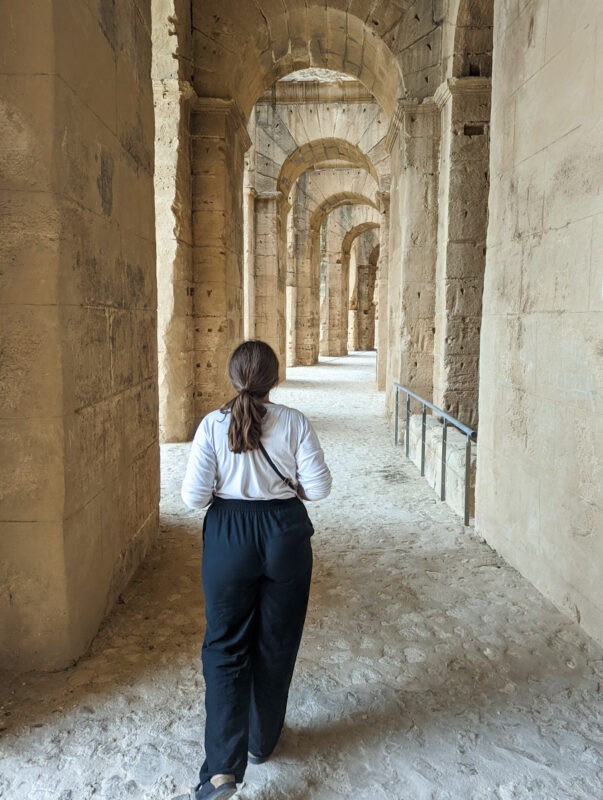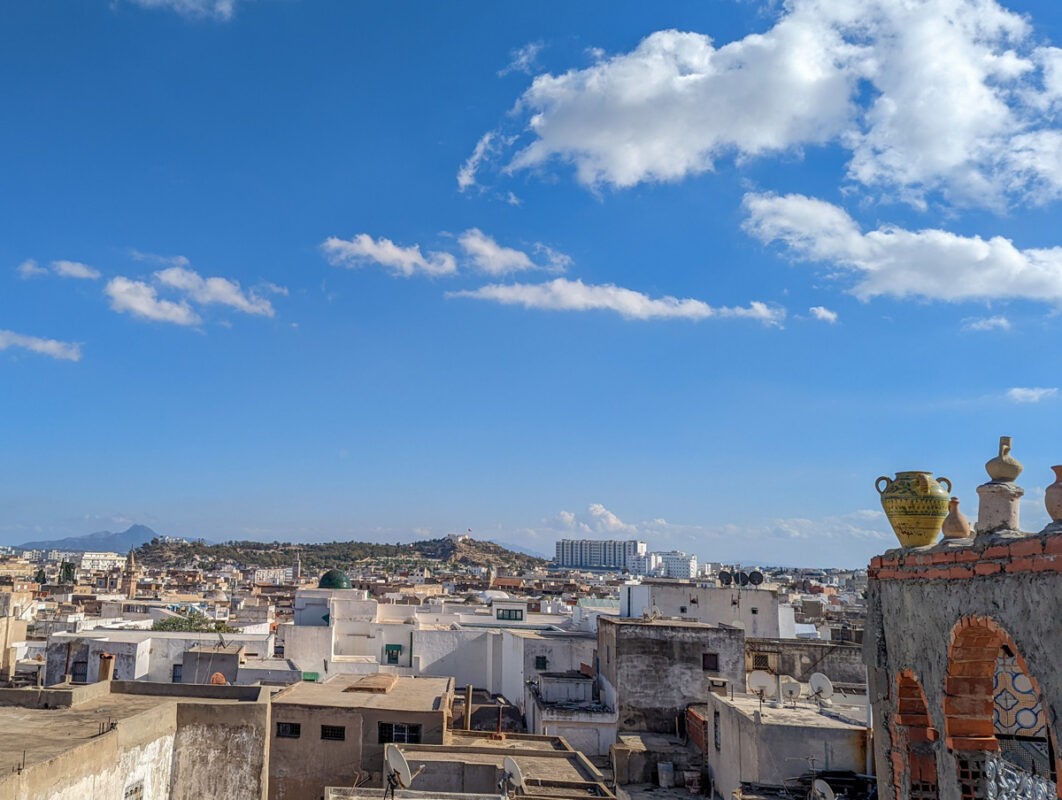A glittering coastline spanning most of the country, desert inland, ancient UNESCO sites and delectable local food – yes, Tunisia’s worth visiting!
In fact, I think this North African country’s a real gem – and if you enjoy exploring this part of the world, you shouldn’t miss it.
Tunisia’s easy to reach from Europe, it has so many allures and it’s a friendly, affordable country to travel around.
So, whether you’re wondering “is Tunisia nice?” or are already planning a holiday, here are my reasons why it’s a fantastic choice, based on my trip there last October.
Is Tunisia worth visiting?

Yes, yes it is.
Tunisia is worth visiting if you:
- Like Mediterranean beaches
- Are seeking the heat in the spring or autumn
- Are interested in history (ancient and early modern)
- Enjoy North African/ Middle Eastern culture
- Want to visit somewhere that’s a little less touristy than say, Egypt or Morocco
If you’re still wondering “is Tunisia a nice place to go on holiday?”, I’ve put together a full list of reasons to visit to help you decide!
Reasons to visit Tunisia
There are so many reasons to visit Tunisia! I went there to enjoy the history and culture – and for a bit of October sunshine – but beachgoers, adrenaline junkies and foodies can all find something to love here.
Rich history

Parts of Tunisia feel like you’re instantly transported back 2,000 years.
You can almost hear the whispers of bygone eras as you tread the cobbled pathways of ancient ruins or trace your fingers over millennia-old inscriptions.
Tunisia’s where the Phoenicians once set their roots, and where the mighty Carthaginians built an empire that rivaled Rome.
The remnants of this illustrious past are beautifully preserved in places like Carthage, the ancient city that saw the rise and fall of the legendary general Hannibal.
The Romans left their indelible mark with sprawling amphitheatres, aqueducts, and the splendidly detailed mosaics that decorate museums across the country – my favourite is El Jem, a smaller version of Rome’s colosseum, with far fewer than 1% of the amount of tourists.
Mediterranean coastline
The vast stretch of Tunisia’s Mediterranean coastline promises shimmering blue waters that meet the golden sands.
Sidi Bou Said, close to Tunis, is famous for its bright white houses that wouldn’t look out of place in Greece, whereas places like Sousse and Hammamet are busier with tourists.
In Tunisia, you can enjoy water sports, explore ancient harbours where Phoenician traders once anchored, or simply bask in the warm sun with a good book in hand.
The sea stays warm in Autumn – I went for a lovely swim on our October trip – and beach days are possible for at least half the year.
Sahara Desert
While Tunisia has a lush Mediterranean coastline, the Sahara’s here too!
Douz is the gateway to the desert, although it’s quite off the tourist trail.
If you’re staying somewhere like Sousse, you can embark on a 4×4 jeep tour that will take you deep into the heart of the dunes.
Multi-day camping trips can also be arranged – giving you the chance to sleep under the desert’s star-spangled canopy and wake up to the spectacle of the sunrise painting the sands in fiery hues.
Don’t miss the oasis town of Tozeur, renowned for its unique brickwork architecture and proximity to the mesmerizing Chott el Jerid salt flats.
This region is steeped in Bedouin traditions, so anyone visiting can learn about their culture and identity.
Delicious food
Tunisian food is underrated but delicious!
It’s a fusion of Berber, Arab, and Mediterranean.
Tunisia’s dishes include “brik,” a delicate pastry envelope filled with a runny egg and capers, fried to golden perfection.
Or perhaps “lablabi,” a comforting chickpea soup drizzled with olive oil, sprinkled with harissa, and seasoned with a dash of lemon.
Then there’s the iconic “couscous,” where grains are steamed to fluffy perfection and served alongside flavorful stews. Veggie options are available!
And let’s not forget the tantalizing desserts: almond-stuffed pastries dripping in honey or date-filled treats that melt in the mouth.
Affordable

Tunisia is a very affordable destination, and you can get quite a lot for your money here.
Whether you’re wandering through bustling souks, feasting on the finest local delicacies, or resting your head in traditional guesthouses (I loved Dar Ben Gacem in Tunis), you’ll find Tunisia excels in giving you value for your money.
Local eateries can be extremely cheap, but even fancy meals out are more budget-friendly than in many places. We had a wonderful meal at Port El Kantoui – three courses each and a bottle of wine came to around 60 euros!
Trains connect some of the main sites, or you could try louages, which are minivans that locals use to travel around. Both are very cheap; but if you want a little more luxury, private guides and drivers are usually affordable too.
Lesser-explored
While the likes of Marrakech and Cairo have long been the star attractions of North Africa, Tunisia remains a well-kept secret.
It’s more touristy than neighbouring Algeria, but away from the beach resorts, you’ll often be the only tourist.
When we visited El Jem, it reminded us a lot of the Colosseum in Rome – but it had literally about 1% of the tourists!
Star Wars Destinations
Are you a fan of Star Wars? If so, you’ve got to go to Tunisia!
The country was George Lucas’s chosen backdrop for many of the scenes from Tatooine, Luke Skywalker’s home planet.
In Matmata the unique troglodyte structures doubled up as the Skywalker home.
There’s also the eerie landscape of Chott el Jerid, where R2-D2 was captured by Jawas.
Ong Jmal, known as the “Camel’s Neck”, is another must-visit spot, bearing remnants of the “Star Wars” set.
Then there’s Ksar Ouled Soltane, a centuries-old granary that became the iconic slave quarters of Mos Espa.
Easy to get to

Did you know that Tunisia is really easy to get to from Europe?
Tunis-Carthage and Edifa Airports are well connected to major European cities. Regular flights shuttle between Tunisia and cities like Paris, Rome, and London.
Moreover, the country’s compact size ensures that once you’re here, getting from one destination to another is a breeze.
Whether you choose to traverse its landscapes by car, train, or even the local “louages” (shared taxis), it’s quite easy to get about!
Bonus if you speak French: Most Tunisians speak the language to at least a conversational standard. I mainly relied on my secondary school French to get around!
However, many younger people and most working in the tourist industry will also speak English.
Excellent hotels
The hotel scene in Tunisia blends luxury and authenticity perfectly.
Whether you’re craving the plush indulgence of a five-star resort in Hammamet, with its ocean-view rooms and spa facilities, or the authentic charm of a traditional “dar” in the historic heart of Tunis, you’ll find it here!
Many hotels seamlessly marry Tunisia’s architectural heritage with modern amenities, ensuring guests experience the best of both worlds.
In places like Sidi Bou Said or Djerba, you might find yourself residing in a centuries-old structure, waking up to the scent of jasmine, and enjoying a rooftop breakfast with unparalleled views.
It’s safe!
After the terror attacks in 2015, many tourists have wondered about Tunisia’s safety; and I’m keen to stress that when I visited, I didn’t feel unsafe once.
Since these attacks, the country has ramped up its efforts to ensure that tourist hotspots, hotels, and historical sites are well-patrolled and secured.
The terror attack risk nowadays feels like about the same – or maybe even slightly less – than in Western Europe.
In fact, there were also attacks in Paris in 2015, and there have subsequently been a few attacks in London.
So, if you’re ok with going to London or Paris, you should be ok with going to Tunis!
I didn’t visit Tunisia as a solo female – my male partner was with me – but I did generally find it comfortable being there as a woman (which contrasts with Cairo, where I did feel quite uncomfortable in a few instances).
The welcoming nature of the Tunisian people shines through, with many locals going out of their way to assist and guide visitors.
While, like any destination, it’s always wise to exercise general caution and stay informed, but it’s also important to not pre-judge a country. And I felt very safe in Tunisia.
Is Tunisia good for families?
Yes, Tunisia’s excellent for families.
There are a range of resorts with kids clubs and activities, and older children will enjoy the history, adventurous activities like watersports and dune buggies and Star Wars locations!
Is Tunisia a nice place to go on holiday?

Tunisia’s a lovely place to go on holiday.
With hot weather from April to October (and mild winters!), a glimmering coastline, great hospitality and plenty of attractions, there’s something for everyone here.
Who Tunisia is good for
Honestly, I think Tunisia’s great for anyone who’s interested in the country.
It squeezes a lot into a small space – beautiful beaches, impressive ruins, great food and the desert.
Families will love the affordable all-inclusive hotels, whereas there’s plenty to satiate any adventurous travellers’ interests!
Have I convinced you to visit Tunisia?
Whether you’re in Tunisia for the sun, beaches or history, I hope this guide has convinced you to book a trip! It’s a wonderful, underrated country that has tonnes to offer tourists. Enjoy!

